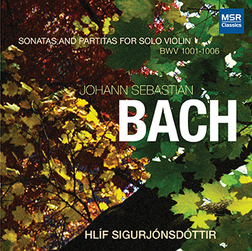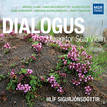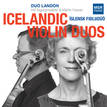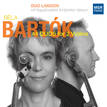JS BACH: SONATAS & PARTITAS
Violin Sonatas Nos.1-3, BWV 1001, 1003 & 1005
Violin Partitas Nos.1-3, BWV 1002, 1004 & 1006
Johann Sebastian Bach
HLíF SIGURJóNSDóTTIR, violin
[
MS1605]
$19.95
LISTEN
REVIEWS
“The solo sonatas and partitas are masterworks of course, full of subtlety and expressive depth. Interpreting these works is a great challenge to any violinist taking them on, and Hlíf Sigurjónsdóttir is fully up to the task...
Let me merely add that this set of the sonatas and partitas could fully satisfy many listeners as one of several important reference sets in these monumental works. Ms. Sigurjónsdóttir plays with an excellent sense for both tempo and phrasing, always articulating with clarity and a flexible means of expression. You won't find her performances stiff or dull, or without passion or commitment... The sound reproduction is excellent. Highly recommended.”
Robert Cummings, Classical Net [September 2016]
“[Hlif Sigurjonsdottir] is a fine technician...”
Magil, American Record Guide [May/June 2016]
“[This recording] provides a welcome opportunity to reconsider some fine-sounding and interestingly interpreted versions of these oft-played pieces. Indeed, 'fine-sounding' is a particularly good description: all the works remain sonically distinguished. Recorded in a church in Iceland, the pieces all offer a sense of resonance, of spaciousness, that is less clean and clear than studio recordings tend to be but far more involving acoustically... The listening experience is a more-involving one than is often the case for these works, which have had many, many fine performances but which tend at times to sound a touch academic and emotionally reserved. The recording venue here provides warmth and presence that gives Sigurjónsdóttir’s interpretations an immediacy and emotional connection... the sheer quality of the playing, and the sound with which it is recorded, make this a very worthwhile two-CD set...”
Mark J. Estren, InfoDad [April 2016]
“[Hlíf Sigurjónsdóttir's resume] doesn't begin to describe the qualities that make her playing so uniquely wonderful to hear... She has a definite affinity for the qualities in these works: the strong, supple lines, the purity of statement, the feeling of movement and rhythm that she communicates to us without undue grandiosity. You get the feeling that she has gotten to the bare bones of Bach’s music, aided by her choice of modern instruments that lend themselves admirably to the requirements of that quintessential master of the baroque... This lady knows her tools and uses them well... just sit back and enjoy!”
Phil Muse, Audio Club of Atlanta [March 2016]
PROGRAM NOTES
CLICK
HERE FOR AN
ENGAGING VIDEO INTERVIEW BY DANIEL KEPL OF PERFORMING ARTS REVIEW
"I have been familiar with Johann Sebastian Bach’s solo violin works since I began studying the violin at an early age with the concertmaster of the Iceland Symphony Orchestra, Björn Ólafsson (1917-1984). He considered these compositions the violinist’s Bible, and I was fortunate enough to play them all under his guidance. Ólafsson’s tutor had been Adolf Busch. My last teacher, Gerald Beal (1932-2002), who studied with Jascha Heifetz for six years, has left his mark on my interpretation, with his inventive fingering solutions and clear musical approach". [Hlíf Sigurjónsdóttir]
Johann Sebastian Bach was born in Eisenach in 1685. At the age of 10, after the death of both his parents, he went to live with his oldest brother, Johann Christoph, who was an organist at Ohrdruf. After working as an organist and court musician, Johann Sebastian was appointed to the court of Margrave Wilhelm Ernst of Weimar in 1708. Six years later, he became the concertmaster of the court. In 1717, he left Weimar for the court of Prince Leopold of Anhalt-Cöthen, where he remained until 1723. He then went to Leipzig, where he lived and worked until his death in 1750. In Leipzig Bach was the cantor at the church of St. Thomas and from 1729 also the director of the Collegium Musicum, which had been founded in 1702 by Telemann.
At Weimar, Bach was employed as an organist, and he wrote many of his organ works during this period. Here he achieved renown as a virtuoso organist. In Cöthen, on the other hand, he had no ecclesiastical duties, but was responsible for all the music performed at the court. During this period, he composed many pieces for a variety of instruments. In Leipzig he composed both devotional and secular works.
Bach composed the six solo violin works - three sonatas and three partitas – in Cöthen in 1720, when he was 35 years old. He based them upon the rich traditions of the German violin school. It has been suggested that he may have composed them as studies, as Paganini later did with his 24 Caprices. It is very clear that Bach was thoroughly familiar with the violin, and his fertile imagination discerned previously unknown potential in the instrument and its music.
"Einleiksverk þessi hafa fylgt mér allar götur frá námsárum mínum hjá Birni heitnum Ólafssyni konsertmeistara (1917-1984), en ég var svo lánsöm að stunda nám hjá þessum frábæra tónlistarmanni. Björn áleit sónötur og partítur Bachs biblíu fiðluleikarans og mér eru þessi verk mjög hugstæð. Lærimeistari Björns var fiðluleikarinn Adolf Busch. Síðasti kennari minn Gerald Beal (1932-2002), sem numið hafði hjá Jascha Heifetz, opnaði nýjar leiðir að þessum tónsmíðum með frumlegum tæknilegum lausnum og tærri músíkalskri nálgun". [Hlíf Sigurjónsdóttir]
Johann Sebastian Bach fæddist inn í þekkta tónlistarfjölskyldu í Eisenach árið 1685. Foreldrar hans létust báðir er hann var barn að aldri og flutti hann þá til elsta bróður síns, sem var organisti í nágrannabænum Ohrdruf, og stundaði þar tónlistarnám. Í upphafi ferils síns starfaði hann sem organisti og um tíma einnig sem hirðhljóðfæra-leikari, en var ráðinn til hirðar Wilhelm Ernst greifa af Weimar árið 1708. Sex árum síðar varð hann konsertmeistari við sömu hirð. Árið 1717 yfirgaf hann Weimar og réðst til starfa að hirð Leopolds prins af Anhalt-Cöthen til ársins 1723. Þaðan fór hann til Leipzig og gegndi stöðu kantors við Tómasarkirkjuna til dauðadags árið 1750.
Meðan Bach starfaði sem organisti í Weimar samdi hann mörg orgelverk og var þekktur og viðurkenndur sem orgelleikari. Í Cöthen hafði hann engum kirkjulegum skyldum að gegna, en bar hins vegar ábyrgð á öllum tónlistarflutningi við hirðina og samdi þá fjölda verka fyrir hin ýmsu hljóðfæri. Í Leipzig skóp hann bæði kirkjulega og veraldlega tónlist.
Einleiksverkin sex fyrir fiðlu, þrjár sónötur og þrjár partítur, samdi hann í Cöthen árið 1720, þá 35 ára gamall. Hann byggir þau á ríkjandi hefð þýsks fiðluskóla. Þær tilgátur eru uppi að hann hafi samið þau sem æfingar líkt og Paganini gerði síðar með Caprisur sínar. Ljóst er að Bach hefur þekkt fiðluna mjög vel og með sínu frjóa ímyndunarafli séð fyrir enn óuppgötvaða möguleika hljóðfærisins.
Hlíf Sigurjónsdóttir was born in Denmark, of a Danish mother and Icelandic father, and grew up in Iceland. Upon graduation from the Reykjavík College of Music, she furthered her violin studies at the Universities of Indiana and Toronto where her teachers were Franco Gulli and Lorand Fenyves, and at the Banff School of Fine Arts. Later she took private lessons in New York from the renowned violinist and teacher Gerald Beal. During the time of her studies, she was fortunate to work with many of the leading musicians of the twentieth century, including William Primrose, Janos Starker, Georges Janzer, György Sebök and the members of the Hungarian String Quartet. Hlíf has given numerous concerts as a soloist and with various ensembles and orchestras. She has premiered a number of works, some of which were dedicated to her. Hlíf has recorded a number of CDs which have been highly praised. Her recent release, Dialogus [MS1551], contains World Premiere Recordings of compositions written for her.
Hlíf Sigurjónsdóttir er fædd í Kaupmannahöfn en ólst upp í Reykjavík. Hún nam fiðluleik hjá Birni Ólafssyni konsertmeistara við Tónlistarskólann í Reykjavík og fór síðar til framhaldsnáms við Háskólana í Indiana og Toronto og Listaskólann í Banff. Einnig nam hún hjá Gerald Beal fiðluleikara í New York borg. Á námsárum sínum kynntist hún og vann með mörgum merkustu tónlistarmönnum tuttugustu aldarinnar, þar á meðal William Primrose, Zoltan Szekely, György Sebök, Rucciero Ricci og Igor Oistrach. Hlíf hefur haldið fjölda einleikstónleika og leikið með sinfóníuhljómsveitum og kammersveitum víða um Evrópu, í Bandaríkjunum og Kanada, leikið inn á upptökur fyrir útvarp, sjónvarp og geisladiska við frábæran orðstír. Hún hefur frumflutt mörg tónverk sem hafa verið samin sérstaklega fyrir hana og hefur einleiksdiskur hennar DIALOGUS hlotið frábæra dóma, m.a. valdi Maria Nockin gagnrýnandi Fanfare tímaritsins hann sem einn af bestu diskum ársins 2015.
PROGRAM
JOHANN SEBASTIAN BACH (1685-1750)
CD1
SONATA NO.1 FOR SOLO VIOLIN IN G MINOR, BWV 1001
Adagio
Fuga (Allegro)
Siciliana
Presto
SONATA NO.2 FOR SOLO VIOLIN IN A MINOR, BWV 1003
Grave
Fuga
Andante
Allegro
SONATA NO.3 FOR SOLO VIOLIN IN C MAJOR, BWV 1005
Adagio
Fuga
Largo
Allegro assai
Performed on a violin by Christophe Landon and with a bow by Isaac Salchow
Leikið á fiðlu sem Christophe Landon smíðaði og með boga eftir Isaac Salchow
CD2
PARTITA NO.1 FOR SOLO VIOLIN IN B MINOR, BWV 1002
Allemanda
Double
Corrente
Double Presto
Sarabande
Double
Tempo di Borea (Gavotte)
Double
PARTITA NO.2 FOR SOLO VIOLIN IN D MINOR, BWV 1004
Allemanda
Corrente
Sarabanda
Giga
Ciaccona
PARTITA NO.3 FOR SOLO VIOLIN IN E MAJOR, BWV 1006
Preludio
Loure
Gavotte en Rondeau
Minuet I
Minuet II - Minuet I da capo
Bourrée
Gigue
Performed on a violin by G. Sgarabotto and with a bow by Gilles Nehr
Leikið á fiðlu sem G. Sgarabotto smíðaði og með boga eftir Gilles Nehr
MSR Classics




